Key Advantages of Cloud Based Services for Hotels and Other Hospitality Providers
In part one of this series on the benefits of cloud-based service for hospitality providers like small to mid-sized hoteliers and franchise locations of nationally known chains, we discussed the key considerations for moving operations to the cloud:
• Reduced capital and IT costs associated with maintaining and monitoring an onsite server and network infrastructure
• Increased flexibility for employees and guests to access critical information that can enhance the overall guest experience
• Options to move repetitive building level operational processes into automated workflows
• Top level security that exceeds industry standards to protect sensitive guest information and payment details
• Peace of mind knowing that critical data is backed up regularly and with smart redundancies to ensure you can pick right back up after an incident should there be a localized event that impacts your organization
• Reliable uptimes and impressive processing speeds that make downtime and apologies for “slow systems” or other failures at the point of guest service a thing of the past.
Specific Use Case Scenarios for Cloud Based Services for Hotel Operators
Let’s break the guest experience down into four primary elements: pre-arrival, check in, occupancy period, and check out.
The right cloud-based platform can give hoteliers and their staff critical insights that create a high level guest experience. from the moment a guest books a room until the day of departure.
Pre-Arrival: In the not so distant past, hotels paid expensive commissions to booking sites, but now cloud services can help hotels with revenue and resource management by offering rooms to the right potential guests at the right prices to increase both revenue and occupancy.
Check in: Plans change. Guests are delayed. Cloud based platforms can help deliver critical information to front desk staff that alleviates guest stress and empowers staff to provide a seamless, white glove experience for harried travelers.
Cloud based platforms also allow hotels to gather data points about why guests are traveling to the destination which increases opportunities for personalized service and special handling of guests with specific needs.
Occupancy: During a guest’s stay, the cloud can help staff anticipate needs by relying on an Internet of Things that underpin the guest experience. From wireless key access to smart thermostats, guests enjoy a frictionless experience while building level maintenance is managed by smart devices on a reliable system.
Should a guest have a less than exceptional experience, cloud-based programs can use machine learning protocols to provide consistent service recovery.
Cloud based hospitality programs can also process pre-arrival and check in data to deliver targeted upsells or suggestions for enhanced guest experiences directly to a guest’s mobile device.
Check-out: The pandemic has changed the way today’s hotel guests want to interact with staff. While forced at first to go contactless, now the majority of guests prefer a self-service experience at their time of departure. But as a hospitality provider, you still want to deliver a top notch check out experience.
A workflow that anticipates the needs of a guest as they leave your property can be built inside your cloud platform. From triggering the delivery of the folio to alerting housekeeping that a room is ready to turn, you can increase efficiency for both guests and management simultaneously. Understanding the day-to-day labor demands helps managers set staffing levels to maximize efficiency, productivity, and guest experience.
The Cloud Offers Flexibility – Even for Properties With Legacy Programs
Sure, these modern cloud platforms modernize hotel management and operations…but what if your property is tied to a desktop loaded legacy system?
You can still get the benefits of the cloud.
The days of having programs and people tethered to desktops is over. Small, mid-sized, franchised, and privately owned hotels can implement a virtual desktop system that allows for the same cost savings and guest satisfying flexibility.
By partnering with a DaaS provider, you can get the same functionality from your current legacy applications as you can with a 100% cloud-based operating system. A virtual desktop takes your current programs and makes them accessible from anywhere on your property — and beyond for authorized users — and from a wide range of devices. Staff can move about the grounds and click into the programs that power your facility to increase productivity and point of sale service opportunities.
Cost savings comes from taking advantage of the cloud provider’s infrastructure to host, process, and store your data safely and securely from an offsite location. No more maintaining an onsite server room or the IT staff to support it.
If you’re currently operating on a hybrid system with some aspects of operations handled by cloud programs and others by desktop programs, you can expect a reduction in capital expenses with increased efficiency of workflows and information exchange between programs and your onsite smart devices.
Want to See Exactly How the Cloud Could Work for Your Hotels?
Trying to migrate to a new tech stack can be disruptive to your business so it’s never a decision to be taken lightly or based on straight sales talk. You have guest needs to meet and revenue goals that need to be considered.
At CyberlinkASP we don’t talk in tech speak, we talk in real speak. Our experts want to understand your needs and then create a customized solution to reduce costs and overhead while improving your guest experience using our state-of-the-art data centers and network capabilities.
Reach out for a personalized demo where we give you the opportunity to put our product to the test under real demands using your data, programs, and workflows.
We are confident we can optimize your current tech so you can get all the benefits of a fully integrated cloud platform even if you have legacy applications that are non-negotiables for running your hospitality business.
Give our hospitality industry insiders a call today and see what the power of the cloud can do for your hotel property.
How Hospitality Providers Can Benefit from the CloudWhen Covid restrictions started, no industry took it harder than the hospitality industry. Now, as falling case numbers signal a return to normalcy for many sectors, hotels are still struggling with reduced work and leisure travel while grappling with increased labor costs and supply shortages.
Those who are traveling have new expectations for the guest experience, which is adding to overall industry pressure.
Could taking advantage of a cloud hosting solution help reduce costs, increase productivity, address staffing issues, and improve the guest experience?
What Are the Advantages of the Cloud for Hotels?
Cloud hosting has been a buzzword in data heavy industries for years but in some ways the hospitality industry has been slower to jump on board. But just as adopting databases allowed hotels to expand reservation functionality in the 1990’s, the cloud offers today’s hoteliers a solution that can improve the guest experience while reducing costs associated with in-house data storage and server maintenance.
You can tap into a reliable, third-party data center to power your day-to-day operations:
• Automation of building maintenance processes and infrastructure support like room access and rekeying
• Flexibility for staff and guests to access information from anywhere to provide a seamless experience with in-demand self-service options
• Redirection of hardware costs and shifting security concerns to a vendor partner — and only paying for the storage you need rather than having to hedge against increased data demands with onsite server closets
• Highlighting guest experiences by having access to personalized information and the ability to provide remote check-in and check-out services that reduce staffing demands while increasing guest satisfaction
• Standardize operations to provide an efficient, repeatable process for all franchisees and locations
• Diversify to ensure disruption and disaster proof operations at scale.
When staff can tap into your back office and guest services systems from anywhere you can avoid the tech glitches and disruptions that can linger in the mind of today’s travelers.
Can You Adequately Maintain Security and Onsite Servers?
Sending data to “who knows where” can seem a little scary, but the reality is that modern cloud vendors operate highly secure data centers where your critical guest information and payment data is guarded through encryption and other compliance measures that exceed current hospitality industry standards.
And because these data centers can meet huge processing demands, you’ll have no idea that your data isn’t down the hall. When guest service functions happen in half the time, guest satisfaction rates rise.
If you continue to store sensitive financial and personal guest information on site, you need a dedicated team so the necessary maintenance and monitoring of the hardware and software is conducted. If technology isn’t your primary focus, it’s easy to create a situation where updates go undone, security lapses, and hardware breaks down. And this puts your operations at risk.
If your onsite system goes down, you probably don’t have an alternate option to get you back and running with only a minimal disruption. You’re at the mercy of either in-house IT staff to work in an emergency or contract labor that may not support you adequately in a crisis or local disaster.
Because disasters do happen. Disaster recovery means being able to quickly rewind to a pre-determined point in time to restore lost data. It also means being able to transfer your hotel or organization’s primary operations using built-in redundancies and protocols at multiple data centers. Offsite cloud storage can be the foundation of your organization’s disaster plan.
A reliable cloud partner will typically be able to promise reliability rates in the 90% range from their data centers. At CyberlinkASP, our service level agreement (SLA) guarantees a 99.99% uptime from our network and associated data centers.
With the right cloud partner, you’ll have built in security with round the clock reliability for on property processes and procedures.
How Can Cloud Services Improve Guest Experiences?
Shifting to the cloud gives hospitality brands the opportunity to exceed guest expectations in a competitive industry. With the right partner, you can leverage the power of cloud hosting to your advantage while reducing operational costs.
Next week, we’ll discuss some specific use cases for cloud hosting services and how these services can directly benefit small, midsize, private, and corporate franchise hoteliers and their guests.
Is a Cloud or Desktop Platform Right for Your Law Firm?At this point, it’s safe to say that e-discovery is here to stay. If you’ve been using a cloud-based or desktop provider, you may wonder which is better for your law firm.
There are considerations to transitioning to a new e-discovery platform and we’re going to break down what you should look for to get the most efficiency out of whichever software program you choose regardless of where it is hosted.
What is E-discovery Software?
In a nutshell, e-discovery software helps busy law firms automate the discovery process by streamlining the uploading, review, and production of case related documents. These programs allow you to assess case files quickly, support internal investigations, and generate public records requests.
Most e-discovery platforms also allow for scheduling critical deadlines and avoid duplication of effort and documentation keeping case files clean and organized.
The right e-discovery tool can reduce the demands of manual review and allow for greater collaboration within your organization and with outside parties.
Case based data loads are only increasing and the right e-discovery platform can increase accuracy and efficiency while keeping errors and overhead low.
When considering any e-discovery software options, it’s important to understand two things:
• Where and how attorneys and support staff will access the program
• Whether your current desktops, servers, and network can meet technical specifications for the program now and in the future as the program is updated
Desktop — or “on site” — E-discovery Software
Once you determine if your current office machines can meet the technical needs of a desktop program, you’ll need to think about the server requirements to keep all your electronically stored information (ESI) secured and accessible from your in-house network.
With all your case files stored on servers in the office, without proper security and backup protocols, your electronic case files are just as vulnerable as paper files once were.
Plus, with an e-discovery program that is licensed to an individual computer, you lose flexibility since the program access is limited to that particular machine.
Many desktop e-discovery platforms advertise on their minimum requirements, so keep that in mind when considering concurrent users and overall processing speed.
The fine print usually recommends increasing memory or even having physically separate drives to increase fault tolerances, reduce processing times, and improve document review performance.
A limitation of many desktop e-discovery platforms is that they are built for the Windows operating system. Or, if you handle large or complex cases, you may not be able to meet the processing demands with individual desktop machines.
Also, with work being native to the workstation on which it was created, if you suffer a hard drive failure, large amounts of work can be lost. Individual workstations are vulnerable to viruses and malware from documents uploaded from client or third-party sites.
And collaborating with other members of the firm is significantly limited in a desktop-based environment.
Acquiring the hardware and maintaining the system needed to run your e-discovery platform are additional costs separate from the licensing fee of the software.
Plus, to keep your network up and running at peak capacity will typically require either in-house or contract-based IT support that may not be available when you need it the most.
Cloud Based E-discovery Software
Cloud-based e-discovery programs tend to mitigate most of the limitations of desktop-based programs. With a cloud-based system, you have access to a much more powerful, secure, and reliable infrastructure to support your e-discovery demands.
Not only do you have more overall computing power to increase efficiency of document review, but a cloud-based product also allows for unlimited members of a team to divide up a large document review project.
Cloud-based programs tend to be more agile and roll out new features sooner than desktop-based products because they aren’t limited by the capability of the average office workstation.
When you log into your cloud-based platform, you’re always operating on the latest version of the software.
Of course, the downside of a cloud solution is the cost of storage for ESI and other demands of legal case management. For small to midsize firms, the cost of cloud storage associated with e-discovery suites must be a major consideration.
Weigh the pros and cons of on-site maintenance against the monthly fees to use the vendor’s secure cloud storage.
With off-site storage, you do have the benefits of backups that are conducted reliably and designed to create redundancies so that critical case files are never lost.
CyberlinkASP Can Give You the Best of Both Worlds
At CyberlinkASP, we aren’t in the business of selling e-discovery software. Our only interest in it is in making sure that you are getting the most benefit from the programs and processes that you rely upon to practice law.
We want to support the business decisions your stakeholders have made with our reliable cloud-based hosting options.
If you’ve determined that a desktop-based e-discovery system is right for your firm, we can help you get the benefits of a cloud-based system by creating virtual desktops that attorneys and staff can access from anywhere and while using their own approved devices.
You get the data security, flexible access, and reliable backups — all with 24/7 support — at a reasonable monthly cost.
If you’re currently using a cloud-based e-discovery system, we can help you get the same flexibility from all your current practice management software programs.
By assessing and integrating your current tech stack, we can help you achieve greater compliance with local, state, and federal regulations for sensitive client data while improving your internal data security and giving you a reliable data recovery plan.
There’s never been a better time to review your practice’s current processes, discover opportunities to streamline your workflows, and uncover ways to control costs.
Contact us now at (972) 779-5260 for more information.
Keeping Up with Legal Technology Trends: Updated For 2022A solid technology stack makes running a modern law office easier, regardless of practice size. Not only do you need to stay competitive, but you also must stay compliant with the ethical and regulatory requirements in your jurisdiction — while maintaining a hybrid work environment.
For most law firms, the pandemic either exposed gaps in their tech plan or caused an acceleration of implementation. Armed with that knowledge, now is the perfect time to evaluate your on-going technology needs for your law firm and how to best address them.
Maintaining a Robust Work from Anywhere Position
Even with pandemic-based restrictions being rolled back, there’s no indication that the new “work from anywhere” option is going away. Not only will employees and attorneys appreciate the flexibility of working securely from home, more than ever you’ll need off-site access to files when working with clients in their offices. Courts will be continuing to rely on technology for filings and for presenting exhibits in the courtroom.
You need a flexible work from anywhere option that allows for attorney travel, unexpected office closures, and the new work dynamic.
Offering a Secure “Bring Your Own Device” Option
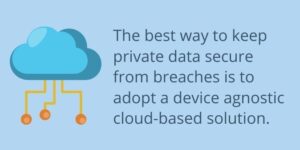 Until recently, you controlled the hardware that was used to access confidential files. Now, you have staff and attorneys who have tablets, phones, and other mobile devices that they want to use for work-related purposes.
Until recently, you controlled the hardware that was used to access confidential files. Now, you have staff and attorneys who have tablets, phones, and other mobile devices that they want to use for work-related purposes.
Even with all these different devices, you can still stay in control of who can access certain files and programs and create sound policies and procedures for user owned devices.
The best way to keep private data secure from breaches is to adopt a device agnostic cloud-based solution that doesn’t allow for any of the firm’s data to be stored on users’ private devices or to be accessed directly over unsecure home or public networks.
Security, Compliance, and PITR to Keep Your Data Safe
Dealing with clients’ private health information, sensitive financials, or intellectual property means that security is never an afterthought. But staying up to date on security patches and protocols can feel like a full-time job.
You know your firm needs to implement multi-factor authentication and other security measures, but you aren’t sure where to start.
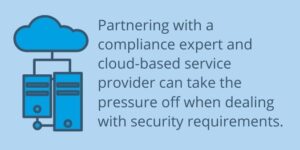 Partnering with a compliance expert and cloud-based service provider can take the pressure off when dealing with security requirements.
Partnering with a compliance expert and cloud-based service provider can take the pressure off when dealing with security requirements.
Look for a cloud partner who:
• Owns and manages a data center that is audited annually to ensure that their security meets or exceeds industry standards
• Operates a 24/7 threat monitoring system that will detect, isolate, and report on any attacks in real time
• Creates complete replications of your data nightly and who has a built-in redundancy plan to minimize data loss in the event of a breach or interruption
• Puts multi-factor authentication in place to secure sensitive data when the firm’s data is accessed from an unauthorized network
Knowing that your work and files are backed up each night reduces overall risk and means that you can recover critical data when the inevitable happens or in the event of a localized natural disaster or other disruptive incident.
Reduce Infrastructure Costs and Improve IT Outcomes
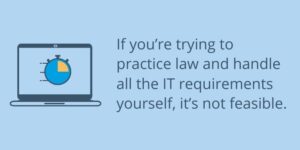 If your technology plan included buying new hardware, now may be the right time to consider shifting your IT costs to a cloud provider. An aging server can limit your options and slow you down. Consider the overall costs to maintain or replace your current hardware versus adopting a cloud-based solution.
If your technology plan included buying new hardware, now may be the right time to consider shifting your IT costs to a cloud provider. An aging server can limit your options and slow you down. Consider the overall costs to maintain or replace your current hardware versus adopting a cloud-based solution.
A cloud-based solution is typically more reliable and cost effective than an in-house system. Plus, with onsite, you have increased IT demands. If you’re trying to practice law and handle all the IT requirements yourself, it’s not feasible. And local IT firms may not offer the help and reliability you need when you need it most.
Your Software Doesn’t Have to be Cloud Based
Changing your platforms or moving away from familiar software can be a challenge. If you’ve thought that going to the cloud wasn’t an option because your software isn’t cloud-based, today’s virtual desktop options give you all the benefits of the cloud while keeping your current programs.
Eliminate the need to buy new software or the downtime that comes with having to train the staff to use it. A virtual desktop option gives you new collaboration opportunities without the overwhelm of learning a new system.
Finding the Right Technology Partner for Your Practice Just Got Easier
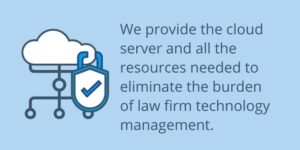 The last three years probably changed the way you’ve looked at your technology and you’re ready to partner with someone who can handle all your data, compliance, and technology concerns.
The last three years probably changed the way you’ve looked at your technology and you’re ready to partner with someone who can handle all your data, compliance, and technology concerns.
At CyberlinkASP, we provide the cloud server and all the resources needed to eliminate the burden of law firm technology management. reduce the monthly costs, while improving security and efficiency.
Because your practice needs are unique, we partner you with our team of industry insiders who are experts in legal technology. We’re fully equipped to handle all your IT needs, from data security, to onboarding new users, to mapping printers, to making sure you are operating off the most up-to-date versions of your software.
Give our legal customer sales team a call today and find out how we can help you.
3 Reasons a Cloud-based EHR System Can Benefit Your Medical PracticeAdopting an electronic health records system was, in large part, designed to improve provider workflows and improve patient experience through enhanced standards of care. Yet many healthcare organizations struggle to achieve the desired outcome with their current EHR system. For some, the primary issue is not the EHR platform itself, but rather where and how the medical records themselves are stored.
With the new reality of healthcare delivery relying on multiple clinical settings under a single corporate entity, interoperability is more important than ever. And as costs rise and reimbursements stagnate, streamlining technology costs is a constant challenge.
Choosing where your data will be stored can make all the difference in patient outcomes, provider satisfaction, and achieving interoperability.
If you’re in the market for a new EHR system — or simply looking to make your current system more efficient — consider these 3 reasons to take your EHR to the cloud.
What Are the Cost Advantages of a Cloud-Based EHR System?
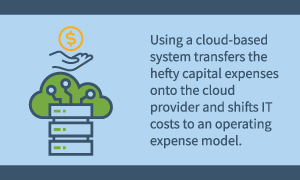 One of the biggest financial drains on a healthcare system that plans to update or optimize their current EHR system is the cost. With in-house systems you can be looking at millions of dollars’ worth of capital investment for a larger organization. Then, there is the on-going maintenance, upkeep, and support required to keep your records system compliant and secure.
One of the biggest financial drains on a healthcare system that plans to update or optimize their current EHR system is the cost. With in-house systems you can be looking at millions of dollars’ worth of capital investment for a larger organization. Then, there is the on-going maintenance, upkeep, and support required to keep your records system compliant and secure.
Using a cloud-based system transfers the hefty capital expenses onto the cloud provider and shifts IT costs to an operating expense model.
Smaller, rural or community hospitals benefit from cloud-based solutions because the cost of implementing and maintaining a cloud-based system is built into the agreement with the cloud provider.
Smaller practices will find a cloud based EHR a cost-effective solution because typically these clinics lack the ability to hire the needed IT support to increase provider satisfaction with EHR platforms.
For both large and small organizations, adopting a cloud hosted solution can reduce costs, increase security, and achieve more efficient levels of communication with both colleagues and consumers.
Are Cloud-based EHR Systems Secure and Compliant?
Typically, most cloud based EHR solutions are more secure than their in-house counterparts. Because medical records typically contain not only sensitive medical histories but also primary identification factors like dates of birth, social security numbers, family names, and patient addresses, data security is critical.
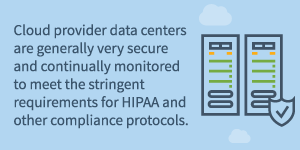 Organizations can discuss very specific needs with a cloud provider who can in turn help to develop and support security protocols that secure patient data while leaving it accessible only to the employees and providers who need it to perform job functions or administer direct patient care.
Organizations can discuss very specific needs with a cloud provider who can in turn help to develop and support security protocols that secure patient data while leaving it accessible only to the employees and providers who need it to perform job functions or administer direct patient care.
Cloud provider data centers are generally very secure and continually monitored to meet the stringent requirements for HIPAA and other compliance protocols. And these data centers are maintained and monitored by well-trained staff who continually test and harden their networks and servers against breaches and other cyberattacks.
With a cloud partner, you have the peace of mind knowing that your system is secure, and that patches and updates are performed to minimize risk and downtime.
Can We Achieve Interoperability with a Cloud-Based EHR System?
Relying on an in-house model significantly limits a healthcare organization’s ability to achieve interoperability. The sooner hospitals, clinics, and associated practices migrate EHR into a cloud-based system, the sooner a safe exchange of health information can occur.
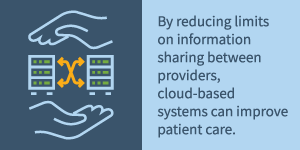 When providers can share critical care data points with colleagues inside an organization, patient outcomes improve, and readmission rates can potentially be reduced. When providers are confident they have all the information on a patient available to them, their ability to optimize decision making is improved. By reducing limits on information sharing between providers, cloud-based systems can improve patient care.
When providers can share critical care data points with colleagues inside an organization, patient outcomes improve, and readmission rates can potentially be reduced. When providers are confident they have all the information on a patient available to them, their ability to optimize decision making is improved. By reducing limits on information sharing between providers, cloud-based systems can improve patient care.
Interoperability will always be a moving target, but if your organization is considering upgrading or optimizing your current EHR hosting situation, the improved data exchange afforded by a cloud-based or cloud hosted patient records system should be a key consideration of your implementation team.
The Benefits of Cloud Based EHR
As the demands of modern healthcare practice keep changing, the most agile organization will be the one using a cloud hosted EHR solution.
Reducing the overall total cost of ownership of the system by transferring the cost of maintaining the infrastructure to a trusted cloud provider, healthcare organizations can effectively improve key budget metrics.
Having a cloud-based or hosted system also allows for increased data security within a regulated network that meets or exceeds current industry compliance standards. This also reduces the IT staffing requirements to maintain the system and support the individual end users.
And, for larger more complex healthcare systems with satellite care centers and affiliated practices, a cloud-based system allows for a secure data exchange that leads to improved patient outcomes and provider confidence in the EHR system.
If you’re ready to consider making the transition to a cloud hosted EHR system, we’d like to talk to you about how we can help you meet your goals and how to position you to best utilize cloud resources to achieve cross organizational KPIs from budget and back office to frontline patient care.
Point in Time Recovery and the CloudIf you’ve ever performed a system update that corrupted your database, you know first-hand how critical having optimized point in time recovery (PITR) targets can be to restoring data and getting your business back up and running.
With every aspect of your business relying on data to get things done, is it smarter to have your critical data backed up onsite, offsite, or using a cloud-based approach?
You need to have the right disaster plan in place before the inevitable failure occurs.
Creating a Data Recovery Plan
As an organization you need to determine your RTO (recovery time objective) which is the maximum amount of time your business can afford to be offline or without access to necessary data and applications.
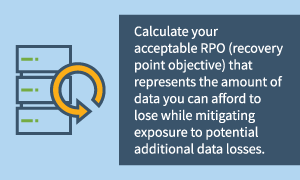 You also need to calculate your acceptable RPO (recovery point objective) that represents the amount of data you can afford to lose while mitigating exposure to potential additional data losses.
You also need to calculate your acceptable RPO (recovery point objective) that represents the amount of data you can afford to lose while mitigating exposure to potential additional data losses.
This is the calculation that determines how frequently the system will back up your data.
You may also have applications in your system that determine a need for different RTO and RPO tolerances. If you run an online marketplace, you may need to restore your commerce application in minutes whereas you may be able to stretch the backup demands for the company wide email to hours. Then choose your customized PITR that is the best for the way you do business.
When calculating your recovery objective values, you need to have a working list of your daily workloads. Then you will assign a tier to those programs and applications. Once you’ve identified your most critical applications, your RTO and RPO will determine the correct PITR to keep minimize data and productivity losses.
Whatever you choose, make sure you also maintain required audit trails to meet your industry’s regulatory requirements.
From this point, you can determine where to store your backups. Because the location of your backup can directly influence your real-time RTO and RPO when you need to perform a system recovery.
Option: Onsite Backups
As with any onsite solution, you need hardware that requires an in-house staff to monitor, manage, and maintain the integrity of the system. Plus, you need a recovery strategy in the event of backup failure, a natural disaster, or generalized data loss.
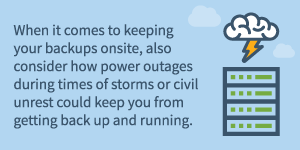 When it comes to keeping your backups onsite, also consider how power outages during times of storms or civil unrest could keep you from getting back up and running.
When it comes to keeping your backups onsite, also consider how power outages during times of storms or civil unrest could keep you from getting back up and running.
Onsite recovery options aren’t always very flexible. Tape drives can’t handle the demands of continuous data protection, and they are susceptible to physical damage. Drives are better and offer faster read/writes, but they take up space, and consume a lot of power. Plus, if you find you need more storage you need to purchase additional disks and install them into the system.
You can also run a dedicated backup server with redundancies designed to avoid a single point of failure. The downside is that in the event of a localized disaster scenario, your server can’t protect data or run required backups.
Option: Offsite Backups
With offsite backups your RTO, RPO, and PITR goals must be modified to consider the distance your data may have to travel to get back to you. This is especially a consideration for offsite physical backups.
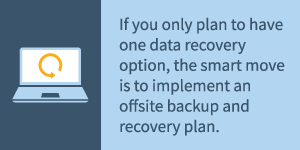 If you only plan to have one data recovery option, the smart move is to implement an offsite backup and recovery plan. It’s increasingly rare these days that an offsite storage solution is going to run physical tape backups but make sure you know the medium that is being used to preserve your mission critical data.
If you only plan to have one data recovery option, the smart move is to implement an offsite backup and recovery plan. It’s increasingly rare these days that an offsite storage solution is going to run physical tape backups but make sure you know the medium that is being used to preserve your mission critical data.
You’re most likely to find that offsite storage is disk based and user-friendly. But keep that RTO and RPO in mind. Even a disk-based recovery solution takes time to recover your entire system to a point where you are fully operational.
However, when you and your backups aren’t in the same physical location your backups may be able to get started restoring critical information and getting necessary applications back up and running getting you back to business faster.
Option: Cloud Based Backups
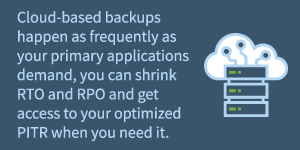 A cloud-based backup scheme is the most agile and scalable solution for preserving data security when disaster strikes. Your data is backed up to virtual servers maintained by your cloud-services vendor. The other benefits of cloud-based backup is that you can partner with a vendor who maintains security protocols that meet the guidelines of your industry.
A cloud-based backup scheme is the most agile and scalable solution for preserving data security when disaster strikes. Your data is backed up to virtual servers maintained by your cloud-services vendor. The other benefits of cloud-based backup is that you can partner with a vendor who maintains security protocols that meet the guidelines of your industry.
And because cloud-based backups happen as frequently as your primary applications demand, you can shrink RTO and RPO and get access to your optimized PITR when you need it.
Have Questions about Disaster Recovery and Backups?
With so many options available to back up your business critical data, it’s easy to feel overwhelmed. Or maybe the onsite maintenance and staffing costs are impacting your bottom line.
If you want to discuss your disaster recovery options, we can help you calculate RTO and RPO and create your PITR targets for your applications. Schedule a call with one of our experts today.
Understanding Service Oriented ArchitectureWith information technology budgets shrinking, more leadership teams are tasked with reconsidering their organization’s overall computing infrastructure, along with the pros and cons of outsourcing tasks that are currently performed onsite.
Do SaaS and cloud-based solutions reduce the need for continuing to consider a service oriented architecture based approach as well?
What is Service Oriented Architecture?
In computing, service oriented architecture is a software engineering style that supports service orientation. Software design uses SOA to allow for service delivery to other components over a network.
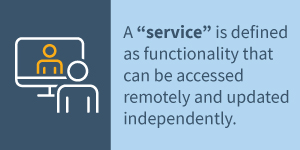 A “service” is defined as functionality that can be accessed remotely and updated independently. An optimized SOA structure is agnostic on vendors, products, and technologies.
A “service” is defined as functionality that can be accessed remotely and updated independently. An optimized SOA structure is agnostic on vendors, products, and technologies.
Inside an SOA structure, a service can represent a repeatable business activity, it can be self-contained, its inner workings are not necessarily obvious to the end user (“black box”), and it can consist of several services working together to create the expanded functionality of a larger software application.
SOA relies on network communication and cooperation at the network level. It can also be used to simplify both the implementation and maintenance of software and to support the interface between different aspects of a computer program.
SOA and Cloud Computing
The modern cloud computing marketplace offers a diverse suite of services to consumers. From simple service offerings that rely on server visualization to operate to the more complex cloud-based services such as the browsers that power mobile devices, the cloud allows for diverse and unrelated organizations to be supported securely by the same platform infrastructure.
These platforms are more agile and can scale more efficiently by adding more processing and storage capabilities to support growth and the operational demands of a customer’s unique web applications, legacy programs, or enterprise level applications.
When service interfaces are well-defined and established, this forms the basis for system-to-system integration and this use of cloud computing is most like a SOA-like model.
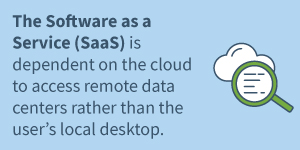 A common example is to think about programs that were formerly loaded from disks onto the end user’s computer — like the office suite software that is now hosted entirely online. The Software as a Service (SaaS) is dependent on the cloud to access remote data centers rather than the user’s local desktop.
A common example is to think about programs that were formerly loaded from disks onto the end user’s computer — like the office suite software that is now hosted entirely online. The Software as a Service (SaaS) is dependent on the cloud to access remote data centers rather than the user’s local desktop.
In SOA style architecture, the cloud-based software components run in a distributed fashion to replicate the functionality of the desktop application while getting the benefits of distributing the processing demands over a robust network maintained by the software service vendors.
SOA and SaaS
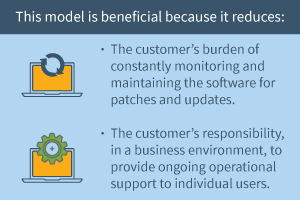 When organizations and end users rely on software that is a hosted service provided over the Internet, the software becomes a service. The SaaS model removes the requirement that the program be locally hosted on the customer’s desktop. This model is beneficial because it reduces:
When organizations and end users rely on software that is a hosted service provided over the Internet, the software becomes a service. The SaaS model removes the requirement that the program be locally hosted on the customer’s desktop. This model is beneficial because it reduces:
• The customer’s burden of constantly monitoring and maintaining the software for patches and updates
• The customer’s responsibility, in a business environment, to provide ongoing operational support to individual users.
Whenever users log in, their applications will be the latest version of the product. The service provider bears the responsibility of maintaining the considerable infrastructure necessary to support complex and resource demanding applications.
For these advantages, there are some downsides. In a SaaS model, the customer loses control over software versioning and device requirement changes. Businesses are completely dependent on the provider’s network to access the application. Also, instead of being a single point of purchase, SaaS is an on-going expense to an organization.
Why SOA Still Matters in a Cloud Supported Environment
By maintaining a service oriented approach, organizations benefit from predictable service behaviors. Control is maintained by providing the opportunity to select common standards for network capabilities.
SOA is also not limited to just software. Components of SOA can be tied together and implemented across a network to provide essential business functions.
Is a Cloud-based Solution Right for Your Organization?
Cloud offerings have several key benefits to organizations that are considering a realignment of their IT department. Commercial cloud providers can effectively manage large portions of the IT needs of even enterprise level organizations.
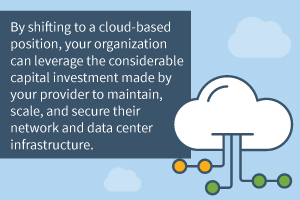 By shifting to a cloud-based position, your organization can leverage the considerable capital investment made by your provider to maintain, scale, and secure their network and data center infrastructure.
By shifting to a cloud-based position, your organization can leverage the considerable capital investment made by your provider to maintain, scale, and secure their network and data center infrastructure.
When uncertainty limits IT budgets, the stability of a cloud provider’s pricing model can be very attractive to companies with the need to scale demand for processing and storage resources – without having to make in-house acquisitions of expensive servers and the payroll costs for the specialized staff required to keep them up and running.
With a trusted cloud services provider, you can turn over the day-to-day operations of maintenance, security, and IT administration and get exactly the suite of services, storage, and processing resources you need at a lower total cost of ownership.
If you’re ready to discuss the benefits of cloud-based services, schedule a customized demo with one of our experts who are specialists in regulatory and security standards for some of the most highly regulated industries.
CyberlinkASP Makes CRN’s Managed Service Provider 500 List Defining SAN and Why It’s EssentialSAN is an acronym that stands for Storage Area Network. It connects servers with storage and in the process, optimizes and pools resources so systems can function better.
When storage becomes a collective resource there are many benefits to businesses, especially those with enterprise level computing needs.
This is why SAN is typically the preferred format in the networked storage market, representing nearly ⅔ of the systems in use by companies with high computing and security demands.
SAN Eliminates Risk from a Single Point of Failure
Because SAN doesn’t rely on a single device, it reduces the overall risk posed from a single point of failure. In fact, a SAN with solid architecture can withstand multiple device and component failures and remain operational.
In fact, in most primary use cases for SAN, businesses that implement it find that SAN improves their regulatory compliance, mitigates disaster recovery risks, and increases business continuity by providing an environment where a dedicated in-house IT department can build and maintain a system that supports enterprise level demands and workloads while end users enjoy responsive applications.
SAN Will Keep Demand Off Your LAN
When you route storage demands through a separate network, you take pressure off your LAN and this proves beneficial to the overall performance of both networks.
Keeping high-impact storage demands from running through your local area network (LAN) frees up bandwidth where you need it while giving the system’s storage demands access to astounding volume.
This means that demanding tasks that require large amounts of storage capacity to operate efficiently can scale up to meet demand without taxing the entire system.
The Trouble with Traditional SAN
The issue for a lot of businesses is the intense, hands-on demands of managing an onsite SAN. When every aspect of the system is locally supported, it requires key employees to constantly monitor the system, to reconfigure switches, and to manually update drivers and security patches.
Can You Benefit from a Hybrid Storage Protocol?
Today’s hybrid cloud has made enterprise level storage more accessible, flexible, and scalable.
By using a hybrid approach, the focus changes at the fundamental level:
• Capital Expense Model to Operating Expense Model: With the primary focus of SAN management being on hardware lifecycles and service contracts, and future acquisitions, sticking to a SAN model can be a challenge in a time of shrinking budgets.
Cloud based costs are an operating expense that is controlled by smart sizing of resources and careful oversight of contracts.
• Improved Security from Partners You Can Trust: There’s no getting around it — when you move to a cloud-supported system, security is a must. Most vendors offer security protocols to satisfy even the most tightly regulated industries. But always make sure that you know your security goals and requirements for data protection. Some aspects will be built into the suite of products and services offered by the vendor while others will be add-ons.
• Understanding What You’re Buying: Coming off in-house SAN management likely means that you’re well versed in the level of control you feel comfortable with when it comes to shared infrastructure. Knowing exactly what you need will help you better assess the tools and products offered by cloud computing vendors.
SAN vs. a Hybrid Storage Model
While scalability, accessibility, and cost control are all attractive aspects of a hybrid cloud storage model, if control is important to your organization, you may prefer a local SAN to handle your data and storage needs.
On the other hand, a reduced TCO on tech might be beneficial to your organization’s bottom line.
In order to determine which path is best for your business, it might be worth it to talk to an expert service provider to get a sense of what the overall costs would be for moving some of your storage needs to a cloud-based environment.
We have a skilled team of customer service professionals who can answer your industry specific questions and build a customized quote to meet your needs.
Understanding Cloud Workspaces and 5 Reasons to Choose OneSimply defined, a cloud workspace is a managed solution that gives your workforce access to the content, tools, and applications they need to perform their work, regardless of location. The days of workplaces being tied together by proximity are in the rearview mirror.
And as the driving force of the pandemic continues to shift, we see more employers and employees grappling with optionality in the workplace and the desire to keep options open when it comes to where work gets done.
Cloud workspaces are the future that is already here. These are the five top reasons your competitors are moving their operations into the cloud.
[vc_separator type=’full_width’ position=’left’ color=’#b3b3b3′ thickness=’2px’ up=’15’ down=’20’]
1. Shrinking IT Budgets and the Benefits of Cost Shifting
You know your current tech assets are only as secure as your least tech-savvy employee. From unintentional data breaches to employees who download seemingly innocent extensions and apps from the internet, your IT staff can be running all day — and often all night — trying to patch holes and stay one step ahead of the next crisis.
Yet, budgets for tech support and new hardware seem to shrink every year. Heavily regulated industries are trying to do more with less while being expected to meet increasing compliance demands.
Imagine shifting your technology costs from a capital expense to an operating expense model? Plus, with a cloud-based workspace, you have increased access to speedier and safer computing, memory, storage, and security resources with a lower total cost of ownership.
2. Streamline Provisioning Tasks and Minimize Hardware Needs
Your employees are expecting radical culture shifts inside your organization. In the traditional model, it can feel like you are always managing provisioning requests. What if you could spend the time you spend managing desktops, managing people?
3. Cloud-based Workspaces Let You Do More With Less Hardware
The endpoint needed to operate your day-to-day activities are only part of the hardware required to run a modern, efficient, and secure digitally supported business. You also need on site servers to house all your most sensitive data.
These servers are expensive and they’re vulnerable. And it feels like a never-ending battle to create and maintain enough capacity to run the programs you require.
And if there’s ever a disaster, you can lose everything if you don’t have a solid and tested data recovery plan.
When you partner with a trusted and credentialed cloud computing service provider, you have the peace of mind knowing your data is being monitored and maintained in a rigorously tested off-site data storage facility.
4. Data Protection is Paramount in a Virtual Workspace
The modern hybrid work model means business gets done on a diverse mix of devices.
Organizations that are subject to heavy regulations are rightly concerned about data security when employees can access sensitive data any time, and from anywhere.
With the right cloud-based workplace solution, you can establish protocols that limit access to necessary information to key employees. And client and patient data is never stored on end user devices.
With a cloud-based workspace your staff has access to encrypted and stabilized storage that keeps them productive and efficient throughout their work day.
5. Flexible and Agile Solutions for a Workforce on the Go
The last three years have shown every organization that you need to be ready for anything. Working from home. Working from a remote location. Big project needs a bigger team. Maybe you use temporary employees to supplement your workforce.
A cloud-based workspace solution lets you spin up and shut down virtual desktops so you can meet demand in real time. Whether your workers are in India or Indiana, everyone has access when they need it and you can control access however you see fit to maintain sensitive data.
Plus, with a virtual workspace partner you can trust, you know that security and compliance are handled and that you are ready for anything.
[vc_separator type=’full_width’ position=’left’ color=’#b3b3b3′ thickness=’2px’ up=’15’ down=’20’]
Two Decades of Cloud Hosting Experience You Can Count On
CyberlinkASP understands that you need the flexibility and reliability that comes from working with an experienced cloud-based solution provider.
We maintain the highest level of compliance, so you don’t have to worry about meeting the ever-changing requirements of your regulated industry. And because we know your business has its own unique challenges, we work with you to design customized solutions supported by our award-winning customer experience team.
If you’re ready to go toe-to-toe with your competition, you need to consider a virtual desktop solution today. We’ll develop a specialized demonstration to see what a cloud-based solution can do for you. Whether you need a per-seat or a per-month solution, we can design a cost-effective solution for your business. Contact us today for a personalized virtual desktop solution for your business.
[vc_row][vc_column width=’1/4′][/vc_column][vc_column width=’1/2′]
Simplify Your Path to Secure Cloud

CyberlinkASP’s Virtual Desktop Hosting and Application Delivery Service provides secure, affordable, and scalable cloud hosting.
[/vc_column][vc_column width=’1/4′][/vc_column][/vc_row]
The Key Benefits of Medical Billing SoftwareIf you’re the person in charge of medical practice management, chances are you’ve explored adding a medical billing software platform to your existing tech stack.
After all, most vendors for medical billing and coding products can offer the typical medical business office:
- Improved claims tracking so you can monitor money in and figure out what’s holding up reimbursements
- Reliability in billing related activities to minimize errors and reduce person hours dedicated to billing tasks
- Sophisticated financial reporting that gives you insights needed to meet and exceed financial goals and to hit business development goals
- Efficiency in coding that produces a more streamlined and accurate process that results in overall claims accuracy
- Reduce or eliminate the need to maintain bulky and vulnerable paper records
- Integration with EHR systems improve patient experience by offering access to billing and payment options which results in quicker payouts and greater financial flexibility
But as software options become more and more integrated into the business model and your day-to-day operations, new challenges will emerge. Especially as more and more employees expect the flexibility of being able to work from home. When you have no idea what the next week or the next month will look like, savvy practice managers need secure flexible options that process claims accurately and on time — every time. No matter where your billing and coding staff is working, the practice must be able to maintain the highest levels of security of sensitive ePHI and patient financial information. To remain one step ahead of hackers, productivity losses from unnecessary downtime, and ever-changing demands from government regulators you need to find a secure, managed solution for your practice staff.
Meeting the Challenges of a Hybrid Medical Billing and Coding Workforce
Whether your staff works down the hall or down the street at home, the right technology can solve potential challenges by providing your healthcare organization with:
• HIPAA compliant solutions to preserve the privacy of both ePHI and patient financial information
• Reliable security for both remote and in-office billing agents and medical coders
• Access to necessary software plus all updates and security patches — without downtime during critical working hours — regardless of your key staffing hours.
Virtual Desktop Solutions for Medical Billing and Coding
Virtual desktops or “desktops as a service” (DaaS) provide a cost-effective solution to maintain the integrity, security, and efficiency of your medical billing and coding platform and the people who power it.
A cloud-based virtual desktop gives your staff secure access to the tools they need to get work done anywhere, and at any time. Even when your staff is providing the access points — at home or on the go — you can be sure their personal mobile devices are just as secure as the end points in your on-site billing office.
With a DaaS or cloud-enabled desktop, you also have access to the most up-to-date security, HIPAA compliance, and the ability to monitor your off-site employees to ensure the highest standards of customer service and established security protocols are being met even when you can’t be there to guide them.
Virtual desktops provide your medical billers and coders to access the software you deem necessary for optimized job performance from any internet-enabled personal devices without any disruption to industry regulated security and privacy requirements.
And because virtual desktops are cloud-based, sensitive patient information is kept secure because it is never stored on a vulnerable endpoint or personal user devices. You can give your workforce freedom and flexibility without risking a compliance crisis because you design the security controls that make sense for your organization. And you can review and update those controls as needed and develop training standards to mitigate risks from an on-the-go mobile workforce.
Virtual desktops also eliminate worries about desktop provisioning and support, software and browser compatibility, data security, or disaster recovery protocols because it’s all built into your customized solution.
CyberlinkASP Offers Virtual Desktops for Your Medical Billing and Coding Professionals
CyberlinkASP can create a customized solution for your organization’s medical billing and coding professionals, so you have peace of mind when it comes to HIPAA compliance and the security of sensitive patient data.
Cloud solutions satisfy stakeholders and keep you online, operational, and optimized even in the face of shrinking budgets and staffing shortages.
We have years of experience designing streamlined solutions for highly regulated industries like healthcare. Plus, we operate state of the art secure data centers that are audited annually to maintain our SSAE-18 Compliance.
Schedule a call today with one of our dedicated customer service team members who is uniquely qualified to give your healthcare organization unparalleled support. We can show you how to increase the security, efficiency, and end user experience of your current software while lowering your overall IT costs.
Must Have Insurance Industry Technology Tools for 2022After “work from home” solutions, the biggest tech changes in most industries are being driven by change in consumer expectations. After 2+ years of having to interact with contactless solutions for everything, your insurance clients expect to be able to do business with you on their own time and on their own terms.
Is your current tech stack ready to meet these new challenges? It can be exciting and overwhelming when you start researching the latest technologies that are available to help with everything from lead generation and quote request automations, to streamlining the claims process and reducing fraud exposure.
The right blend of technology can help you solve pain points and bottlenecks in your current business processes while giving you the flexibility to grow your business while you only handle the tasks that can’t be automated.
The goal of technology isn’t to replace the human in the equation. It’s highest and best use is to enhance the customer experience, so you build more positive relationships and receive more referrals from happy clients.
AI Powered Solutions to Build Your Insurance Business
The problem with a lot of legacy and business-in-a-box technology solutions for insurance is that they weren’t built with the end users in mind: the customer or the agent.
Right now, the hottest trend across industries — and insurance is no exception — is using artificial intelligence and machine learning to improve the customer experience. And one of the best places your small, independent insurance brokerage can utilize AI is with chatbots.
Chatbots can take limited payroll resources and multiply their effectiveness by responding to inbound leads 24/7. You might be feeling old school that customer service always requires a personal touch, but the pandemic has really changed consumer perception of self-service being good (even great!) service. Giving potential customers a way to connect with you on their time is an easy way to improve client satisfaction.
Today’s chatbots are clever, adaptable, and you can even personalize the experience as much or as little as you like. Free up your human staff to work on doing tasks that chatbots can’t.
Give Your Customers the Same App Options The “Big Guys” Offer
Remember the old Apple App Store slogan, “there’s an app for that?” If you’re an insurance agent for a single company, you probably do have an app to offer your clients. And nowadays, apps for handling everything aren’t the exception…they’re the rule.
There’s a significant gap in app usage between independent insurance agents and brokers and their clients when compared to the traditional insurance companies and their insureds.
Consider incorporating a seamless client experience dashboard into your business offerings to improve access to expected self-service options like bill pay, documentation downloads, and improved claims efficiency.
Drones Can Perform Insurance Inspections Safely and Efficiently
If you didn’t get a drone for Christmas, you might want to consider buying one and getting a jump on your business deductions after reading this:
Drones can help you give your clients more accurate policy quotes and assist during stressful claim situations.
Most independent insurers find themselves working with clients who have needs that can’t be adequately serviced by just plugging a few details into an online lead form and having a quote pop out. If this is your niche as an independent insurance brokerage, flying a drone can give you information that can help you find your clients the right policies with the right coverages — and without you having to guess or climb ladders for confirmation.
Beyond common roof inspections, a drone can get a visual overview of a large commercial property quicker than a human which can turn what used to be days in the field into hours. And that frees you up to meet with more leads and generate more business while building a happier book of business.
Having a way to gather high resolution images can help clients if there is ever a natural disaster. A drone can keep humans out of dangerous and hazardous sites while still being able to gather needed information to assist clients during a stressful situation.
Technology Can Detect Fraud in the Insurance Claims Process
Just like AI can assist you with helping clients, it can also help protect against fraudulent claims data being used by the unscrupulous. From checking metadata on uploaded images in the claims portal to scanning social media, fraud prevention AI can stop both individual and network initiated criminal claims.
Using machine learning, these AI platforms create complex datasets that recognize current fraudulent claim techniques while adapting to new and emerging threats.
Agents Work More Efficiently in the Field with Virtual Desktop Access from Anywhere
Not only have customer demands changed when it comes to tech, your employees and agents demand creative solutions that allow them to work more efficiently from home, a coffeeshop, or at a client’s location.
If you are currently operating off of several products and platforms that don’t play well together or on your agents’ mobile devices, it’s time to consider moving to a cloud-based solution that streamlines your desktop into a mobile solution that gives your people more time to make more sales without having to deal with clunky, confusing, or vulnerable access points.
If you’ve explored options to improve the employee experience and improve operational efficiency, consider the benefits of cloud-based solutions and virtual desktops to keep mobile business compliant and secure.
Not sure where to start? Talk to one of our cloud hosting experts today. We can develop a personalized solution that will handle all your documentation, compliance, and security needs so you can focus on growing your insurance business.
